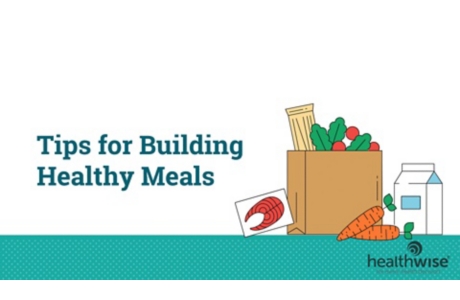Overview
What is healthy eating?
Healthy eating means eating a variety of foods so that a child gets the nutrients he or she needs for normal growth. These nutrients include protein, carbohydrate, fat, vitamins, and minerals. A child who regularly eats a wide variety of foods from all food groups will be well-nourished.
How much food is good for your child?
Many parents worry that their child is eating too much or too little. Keep in mind that every child has different calorie needs. Children tend to eat the same number of calories every day or two. It's usually best to provide healthy foods and let your child decide how much to eat.
Why pay attention to what your child eats?
Children with poor eating habits don't get the nutrients needed for healthy development. This can lead to being underweight or overweight. They tend to have weaker immune systems, which increases their chances of illness. They may be at higher risk for heart disease, high blood pressure, type 2 diabetes, and high cholesterol later in life.
How can you help your child learn about healthy foods?
Help your children understand healthy eating by teaching them about food—where it comes from and what nutrients it contains. You may be able to grow some food in your yard or in a pot. Older children can help you cook or help with shopping.
How can you help your child get started with healthy eating?
Here are some ideas for getting your child started with healthy eating. If you have other ideas that work for your family, add them to the list.
- Set up a regular snack and meal schedule.
Most children do well with three meals and two or three snacks a day. When your child's body is used to a schedule, hunger and appetite are more regular.
- Find at least one food from each food group that your child likes.
Make sure this food is available most of the time. Don't worry if your child likes only one vegetable or one or two kinds of meats or fruits. Kids tend to accept new foods gradually, and their preferences expand over time.
- Provide a healthy breakfast.
A quick, healthy breakfast could be high-fiber cereal with milk and fruit, nonfat or low-fat yogurt, or whole-grain toast.
- Eat as a family as often as possible.
Keep family meals pleasant and positive.
- Limit junk food.
Get healthy snacks that your child likes, and keep them within easy reach.
Health Tools
Health Tools help you make wise health decisions or take action to improve your health.
Changing Your Child's Eating Habits
Childhood is a great time to learn healthy eating habits. Healthy eating can help your child feel good and stay at a healthy weight. It can help your child have plenty of energy to learn and play.
Healthy eating includes:
- Offering your child a variety of fruits and vegetables, whole grains, lean proteins, and low-fat dairy.
- Limiting sweet liquids, like soda, fruit juices, and sport drinks.
- Choosing foods that are lower in saturated fat, sodium, and added sugars.
Changing your child's eating habits can take time. That's common. You can start with small changes and add to them over time.
Getting started
Here are some ideas to help you start thinking about making healthy changes to your child's eating habits.
- Get support. Your child's doctor can help you find a dietitian who can help you with making healthy changes.
- Talk with your child about what kinds of changes might work for your family. Discuss eating habits or certain foods you might want to change. And talk about anything you want to keep.
- Make one small change, and see how it works. Try things like offering water when your child is thirsty or serving fruits as snacks. Or add one vegetable to your family's dinner.
It takes time to adjust to new habits. Remember that you can control how fast you make any changes. You don't have to change everything at once. Making small, gradual changes can help your child adjust to new eating habits. And you may find that after awhile your family likes this new way of eating.
The decision to change and how you do it are up to you. You can find a way that works for your family.
Helping Your Child to Eat Well
Childhood is the best time to learn healthy habits that can last a lifetime. Here are some ways to help your children learn healthy eating habits.
- Set up a regular meal and snack schedule.
Most children do well with 3 meals and 2 or 3 snacks a day.
- Have your child eat a healthy breakfast.
Try cereal with milk and fruit, nonfat or low-fat yogurt, or whole-grain toast.
- Eat as a family as often as you can.
Keep family meals pleasant and positive.
- Start with small, easy-to-make changes.
Try adding more fruits and vegetables at meals and snacks. For example, put some fruit on your child's morning cereal, and include carrot sticks in your child's lunch.
- Offer new foods.
- When trying a new food at a meal, be sure to include another food that your child already likes.
- Don't give up on offering new foods. Children may need many tries before they accept a new food.
- Provide healthy options.
- Get healthy snacks that your child likes, and keep them within easy reach.
- Limit sweet drinks. Encourage your children to drink water when they are thirsty.
- Make fast food an occasional event. Order the smallest portions available.
- Let your child decide how much to eat.
- Children can tell when they are full. When we try to control how much children eat, we interfere with this natural ability.
- You decide when, where, and what the family eats. Your child chooses whether and how much to eat from the options you provide.
- Avoid using food as a reward.
Find other ways to reward success in school or sports. And don't reward desired eating behavior (such as trying a new food). If you serve dessert, consider it part of the meal, not a treat to follow the main course.
- Be a good role model.
Your own eating and lifestyle choices are a powerful teaching tool. Your child sees the choices you make and follows your example.
Children's vitamin and mineral needs
Children need a variety of nutrients (such as protein, carbohydrate, fat, vitamins, and minerals) for normal growth. But at certain stages, children have special vitamin and mineral needs.
Infants
Babies need a source of iron.
- The American Academy of Pediatrics recommends iron supplements for breastfed babies. Supplements should start at 4 months of age for full-term babies and by 1 month of age for preterm babies.
- Use iron-fortified formula for formula-fed babies.
- When you start your baby on solid foods, include high-iron infant cereals and/or meat baby foods.
Infants may also need a daily vitamin D supplement. Talk with your doctor about how much and what sources of vitamin D are right for your child.
Children ages 6 months to 16 years
Some children this age may need extra fluoride. If your child needs extra fluoride, your dentist may recommend supplements.
- Use these supplements only as directed.
- Keep fluoride supplements out of the reach of children. Too much fluoride can be toxic and can stain a child's teeth.
Girls ages 9 to 18 years
Girls ages 9 to 18 years need extra calcium and may not get enough calcium from the foods they eat.
- Encourage your child to eat calcium-rich foods such as milk, yogurt, cheese, and canned salmon with bones. Calcium is also added to foods such as calcium-fortified orange juice, some cereals, soy drinks, and tofu.
- If your child doesn't get enough calcium from foods, she may need a calcium supplement. Ask your doctor to recommend one. Be sure to choose a supplement that includes vitamin D. The body needs vitamin D to absorb calcium.
Learn more
- Added Sugars
- Feeding Your Child Using Division of Responsibility
- Feeding Your Infant
- Fluoride During Childhood
- Getting Enough Calcium and Vitamin D
- Healthy Eating in Children: Problems Caused by Poor Nutrition
- Healthy Eating in Children: Things That Influence Food Choices
- Snack Ideas for Preschoolers
- Your Toddler: Nutritious Meals for Picky Eaters
Watch
Related Information
Credits
Current as of: October 24, 2023
Author: Healthwise Staff
Clinical Review Board
All Healthwise education is reviewed by a team that includes physicians, nurses, advanced practitioners, registered dieticians, and other healthcare professionals.
Current as of: October 24, 2023
Author: Healthwise Staff
Clinical Review Board
All Healthwise education is reviewed by a team that includes physicians, nurses, advanced practitioners, registered dieticians, and other healthcare professionals.





